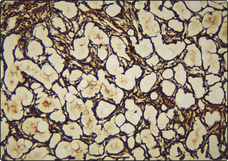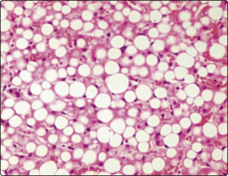Chapter 53 Fatty change and cirrhosis
Fatty change
Fatty change (steatosis) is the most common response of the liver to injury. Morphologically, it is characterized by the accumulation of globules of lipid within the cytoplasm of hepatocytes. In most cases, the globules enlarge and coalesce until the nucleus and cytoplasm of the cell are displaced to the periphery; this is known as macrovesicular steatosis (Fig. 3.53.1). In microvesicular steatosis, the globules all remain small. There are many causes of fatty change, including ethanol, drugs, toxins, diabetes mellitus, obesity, hypertriglyceridaemia, protein malnutrition, total parenteral nutrition and severe systemic illnesses.
Fatty change accompanied by inflammatory changes is steatohepatitis (Fig. 3.53.2), which is characterized by infiltration of the parenchyma by neutrophils, swelling of hepatocytes (ballooning degeneration), and Mallory bodies, which are tangles of intermediate filaments and ubiquitin, seen on H&E stained sections as bright pink hyaline inclusions. Collagen production by stellate cells causes fibrosis (Fig. 3.53.3), which can progress to cirrhosis.

Fig. 3.53.2 Alcoholic steatohepatitis. The hepatocytes show ballooning degeneration and many contain Mallory bodies.

Fig. 3.53.3 Pericellular fibrosis in a patient with alchoholic liver disease. This reticulin stain demonstrates the increased amounts of collagen in the perisinusoidal spaces.
The most common cause of fatty change and steatohepatitis in industrialized countries is chronic alcoholism; the diseases are called alcoholic fatty change and alcoholic steatohepatitis, respectively, whereas those caused by conditions other than ethanol toxicity are called non-alcoholic fatty change and non-alcoholic steatohepatitis (NASH), respectively. The commonest cause of NASH is metabolic syndrome (Ch. 51). Fatty change is completely reversible, provided the aetiology is eliminated. Steatohepatitis is also reversible, provided the fibrosis is not too far advanced.
< div class='tao-gold-member'>
Stay updated, free articles. Join our Telegram channel

Full access? Get Clinical Tree








